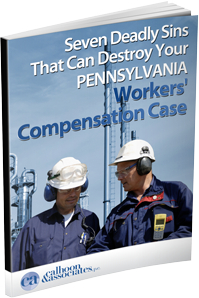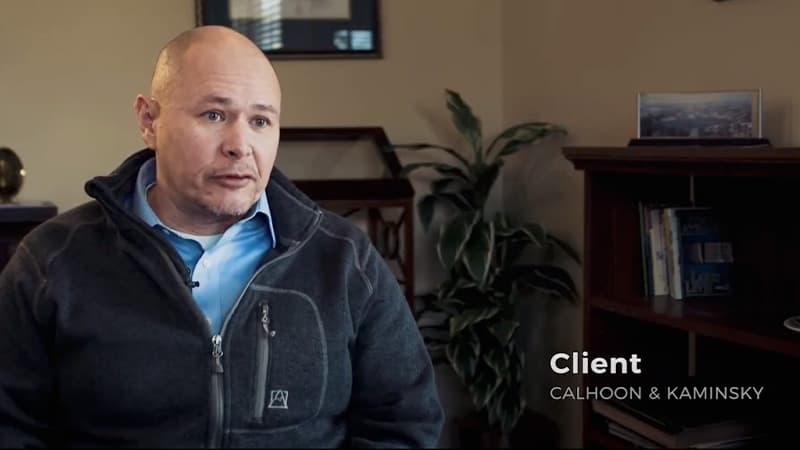-
- Leah Tomlin“Matt Kaminsky is an absolute pleasure to work with! He knows what he’s doing and is truly all about his clients. If you ever have a work injury don’t ever go to anyone else. He truly is the best.”
- Cody Brown“Eric was extremely helpful and made sure I understood everything and made the process a lot easier for me. He gave me all the information to make an educated decision.”
- Blaine“Awesome attorney from beginning to end!!! I had a really hard case against a huge employer group, and Ron settled with enough for me too buy my dream home outright!”
- Dylan“Very Knowledgeable and fast! I would highly recommend Matt Kaminski to anybody looking for help with their Workers compensation Cases. He’s quick to respond with any questions you have too great lawyer!”
- Bob“Matt knew there every step. Always took my phone calls or promptly called me back. enjoyed working with him. Made a bad time easier to deal with, Thanks again.”
 Free Consumer Guide7 Deadly Sins That Can Destroy Your Pennsylvania Workers’ Compensation Case
Free Consumer Guide7 Deadly Sins That Can Destroy Your Pennsylvania Workers’ Compensation Case
Case Results
Results Calhoon & Kaminsky has gotten for those looking for help with workers' compensation
Results*. Isn’t that what you’re looking for when you you’ve went months without a paycheck, the bills are not getting paid, and you can’t get the medical treatment you need to get back to work.
If you’re tired of the run-around and just want your problems taken care of, give us a call at 717-695-4722 or 1-877-291-WORK (9675) if the call is long-distance.
Client Testimonial | Calhoon & Kaminsky
"I would recommend anyone to get representation from Ron and Matt as soon as possible. They can guide you and point you in the right direction and tell you what's next. They don't treat you like clients. They don't treat you like you're just somebody that comes in and
your name's on a folder. They treat you like real people."
Case Study
The Claimant, a resident of Lewistown, Dauphin County, filed a Review Petition on March 14, 1996, alleging that the Employer has failed to pay the Claimant’s workers’ compensation benefits on a weekly basis. The Claimant was paid on a weekly basis prior to his work injury. After the Claimant was placed on compensation, he received it on a weekly basis. After the Employer, ABF, acquired Carolina Freight Carriers, the Claimant received it on a biweekly basis. The Claimant received some of the biweekly checks two to three weeks late, causing his bills to be paid late.
Defendant’s Modification Petition and Petition for Review of Utilization Determination denied and Claimant’s Review Petition to expand the accepted description of injury granted. Bennett (name changed for this summary), an Iron Worker, was injured in the course of his employment in Ephrata, PA. State Workers’ Insurance Fund, the workers’ compensation insurance carrier for the employer, had issued a Notice of Compensation Payable (NTCP) on January 20, 2006 for Mr. Bennett’s August 17, 2005 injury described as groin / bilateral inguinal hernia.
Karl Langston (name changed for this summary) was injured in the course of his employment in Jim Thorpe, PA. Inservco, the workers’ compensation insurance carrier for the employer, issued a Notice of Compensation Payable (NCP) on February 11, 2015 for Mr. Langston’s January 29, 2015 injury described as a left wrist sprain. Claimant’s benefits were suspended on February 9, 2015 when he returned to work.
One of our clients purchased this new home on 2 plus acres in Elk County where he and his wife watch the Elk come to feed in the evenings. The purchase price was paid in full with Blain’s workers’ Compensation Settlement from his ankle injury.
An union employee from Ashley, PA, working as a supervisor for a youth services group sustained a work injury described as a left shoulder rotator cuff tear in April 2011, which the insurance carrier accepted. The injured worker had returned to work but was later taken back out from work by his physician for a surgery to repair the tear of his rotator cuff.
Injured worker, Sam, suffered a work injury to his left knee, an MCL tear. He was off all work for a year, and during that time, had left knee surgery, which did not fully heal his knee.
Samuel Newton (name changed for this summary) was injured in the course of his employment in Waynesboro, PA. Mr. Newton testified that he had been receiving both total temporary disability (TTD) benefits and total partial disability (TPD) benefits per the Pennslyvania Workers’ Compensation Act based upon a Supplemental Agreement dated November 5, 2013. On January 29, 2014, Neil P. O’Malley, M.D., placed Mr. Newton off from work. Mr. Newton testified that he contacted the insurance adjuster to receive his workers’ compensation check but did not receive it until the second week of March 2014.
Kyle Kenny was employed as a maintenance supervisor in Harrisburg, Pennsylvania (PA). He suffered a work injury to his back when he was moving 4 big and bulky mats that weighed over 100lbs. When he lifted the 4th mat, it jerked him badly. He sat down to take a break and started to feel a little back pain. Shortly after sitting down, his legs began to badly tingle and he was soon unable to move them. His co-workers called an ambulance for him and he was taken to the hospital. Kyle is currently paralyzed from the waist down. His work injury was accepted by Notice of Compensation Payable and his injury was described as “Lumbar Strain”. Often Workers’ Compensation Insurance carriers list a legally accepted injury simply as a “strain”. This is a tactic to minimize what disability and what medical expenses the workers’ comp carrier has to automatically pay.
Ed Templeton of Lebanon, PA recently prevailed on a penalty petition for unpaid prescription drugs. Mr. Templeton had, many years ago, signed a Compromise and Release Workers’ Comp Settlement Agreement, releasing Kleinfelter Chevrolet (his employer) and Federated Mutual Insurance Company (the Workers’ Compensation insurer) from all future wage loss. As part of the C&R agreement, both sides agreed to keep medical coverage open so that Mr. Templeton could continue to get the treatment he required following his work –related injury by having the workers’ comp carrier pay for lifetime medicals relating to the work injury.
Ben Thomas (name changed for this summary) was injured while working as a mechanic for Ramtech, Inc. in Chambersburg, Pennsylvania. Mr. Thomas’s injury occurred while he was putting a motor into a Humvee. Like many people who suffer from a work-related injury, Mr. Thomas didn’t initially understand the severity of his injury; Mr. Thomas initially thought he was suffering from regular muscle pain that would go away after a few days. Mr. Thomas had actually suffered a herniated disc at L5-S1. He continued to work until he realized the pain was not going away.
*Please note that every case is different, and the following case results (though accurate) may not reflect the amount of compensation you will receive in your case. Prior results are not a guarantee of future results as every case is unique and factually different.





